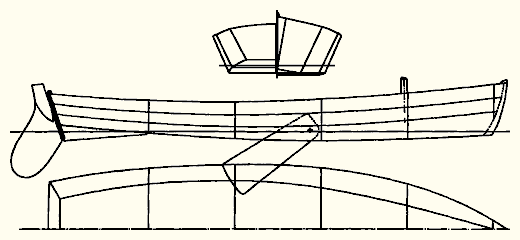
| Dickey A 14' 7" Flat-Bottom Sailing Skiff By William Atkin |
| A Sailing and Outboard Skiff | |
| Well, here is Dickey, designed to refute the notion that a flat bottomed boat will always row hard and sail indifferently. | |

| |
| The sail plan is not designed for racing; rather for handy sailing and for beginners in sail. The area of the sail is 72 square feet. It must be made from light duck, preferably balloon cloth. A sail is of little use if it is improperly cut and made. Draft must be in the right place and the leach and foot correctly designed. It is always good practice to go to a good sailmaker for sails. After all, sails are power and should be efficient if satisfactory results are expected. | |

| |
| Dickey is 14 feet 7 inches long, 13 feet 4 inches on the water line, 4 feet 2 1/2 inches in breadth and 4 inches draft (without the centerboard). The freeboard at the bow is 1 foot 7 inches and at the stern 1 foot 3 inches. So you see this is not a tiny shallop in which to row among lily pads. It will be noticed that the bottom is much narrower than the deck; in other words the topsides have generous flare. Now when you see any kind of skiff that is as wide, or nearly so, on bottom as it is on the deck you will know the boat will be tippy, that is, unstable. Generally speaking the more flare the topsides have the safer and better the boat will be. Unfortunately you will find few skiffs of the latter kind; most will be nearly slab-sided, more's the pity. It will be noticed too that the fore and after sweep of the bottom of Dickey is a fair curve, not a straight line with a quick turn-up aft. Fair curves pass through water easier than humpy curves; and the easier a boat passes through the water the less power is needed to propel it. Another feature which helps the progress of a skiff through the water is reasonable sharpness of the water lines forward. Also this eases the tendancy all flat bottom boats have to pound in rough water; this being especially true when the boat is under the urge of an outboard motor. By curving the stem, better appearance is obtained with very little additional work. | |

| |
| If the little boat is to be used with outboard motor and for rowing only it is, of course, not necessary to build the centerboard trunk or the rudder. The thwarts, however, should remain as located on the plans, leaving out the one in the forward end which serves as a bench for the mast. There is no sense in having too much power; up to 4 h.p. is ample. | |
| Plans for Dickey are $100 MYSTIC SEAPORT MUSEUM SHIPS PLANS STORE https://store.mysticseaport.org/ships-plans/ shipsplanstore@mysticseaport.org
+1 (860) 572 5360 | |
| BACK TO PLAN LIST | |